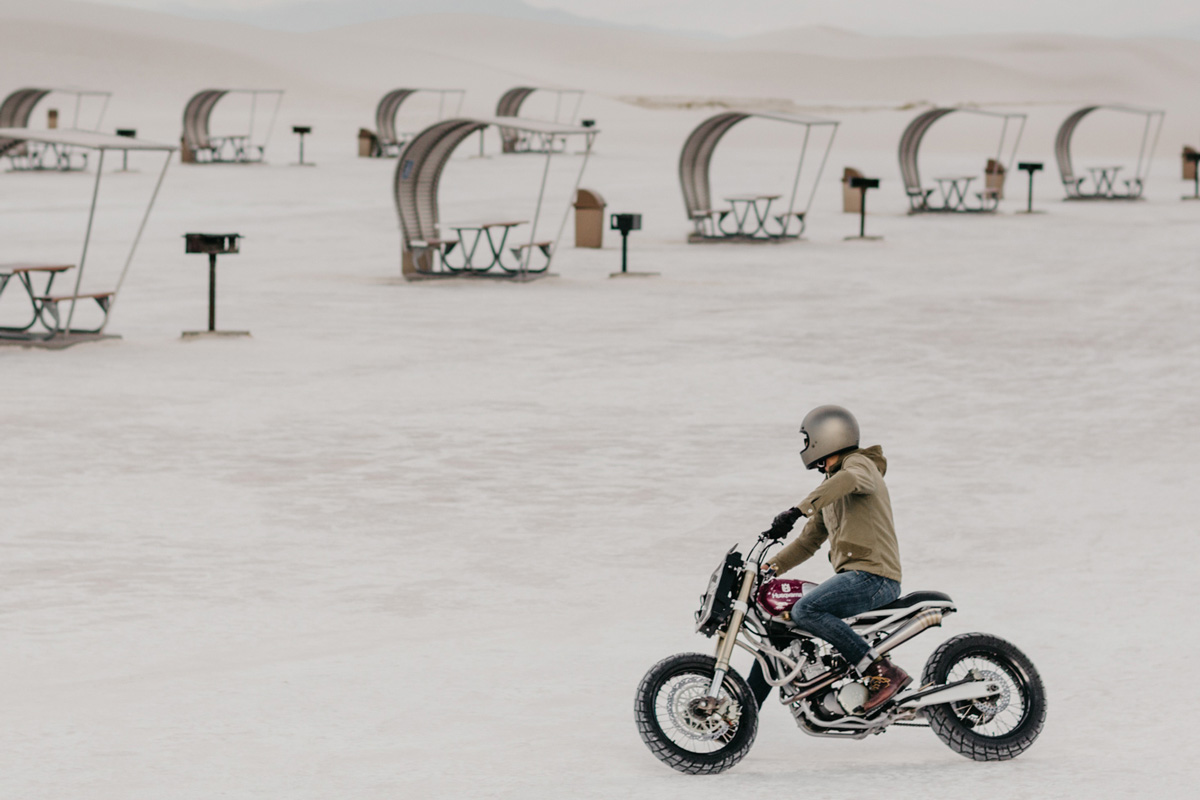Pre-COVID, we had ridden close to 2,000 rugged miles through Vietnam, from dense cities, choked on crazed scooter riders, to pastoral rice fields sprinkled with farm animals. Our group—which included custom motorcycle builder Dave Mucci—spent two weeks hurling a fleet of new Ducati motorcycles across one of the most amazing, and mountainous, countries on Earth. It was the kind of trip motorcycle riders fantasize about their whole lives, and we devoured it. We returned home to the States changed people, having mainlined the potent elixir that is traveling with friends by motorcycle.
I looked at my gear, most of it was trashed from the terrain and weather I put it through. Ripped jeans, soggy gloves, bashed in helmets, and a pair of grimy Red Wing boots (they had sponsored the trip and gifted us each a pair) sat in a pile in the center of my house. I wasn’t sure what to do with it. Toss it? And then, Dave sent us a group text: “Look guys, good as new.” In the photo were, what looked to be, a brand-new, gleaming, perfectly conditioned pair of boots. He had done, what I’ve learned he does often—apply some “Mucci magic” to them, breathing brilliant new life into something old and broken.
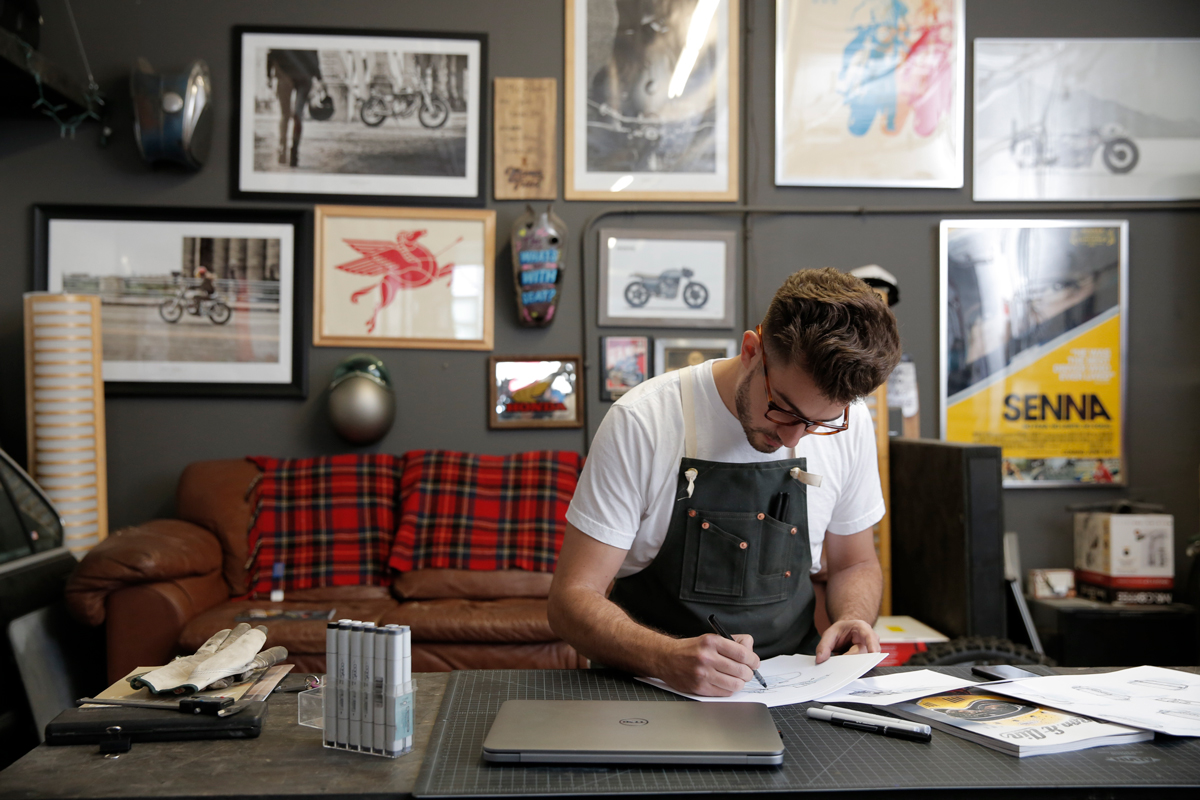
“I’m often trying something for the first time, whether it’s a new process I’m learning or an unconventional way of building a piece,” says Dave Mucci. Photo by Brian Sorg
Dave has a deep, methodical love of the craft of motorcycles, so much so I tend to think of him as his Instagram handle and shop name, Moto Mucci. His custom-built bikes have been invited to several prestigious invitationals, like the One Moto Show and Handbuilt Show, which led him to the build-off TV show Wrench Against the Machine. He has a reverence for design, but finds glamor in the well-worn—note the tank on his impeccably built Husqvarna TE570, its dents and scrapes carefully preserved.
Dave’s design talents go well beyond shining boots and motorcycles with magic. As a student at the College for Creative Studies in Detroit, he learned the foundation of product and transportation design. His shop now serves industry-leading clients like Snap-On, Progressive Suspension, and Bosch. His work often begins in exhaustive research, hundreds of renderings, and meticulously made mockups. I spoke to Dave about design, when craft elevates to art, and the current state of custom motorcycles from his shop in Portland.
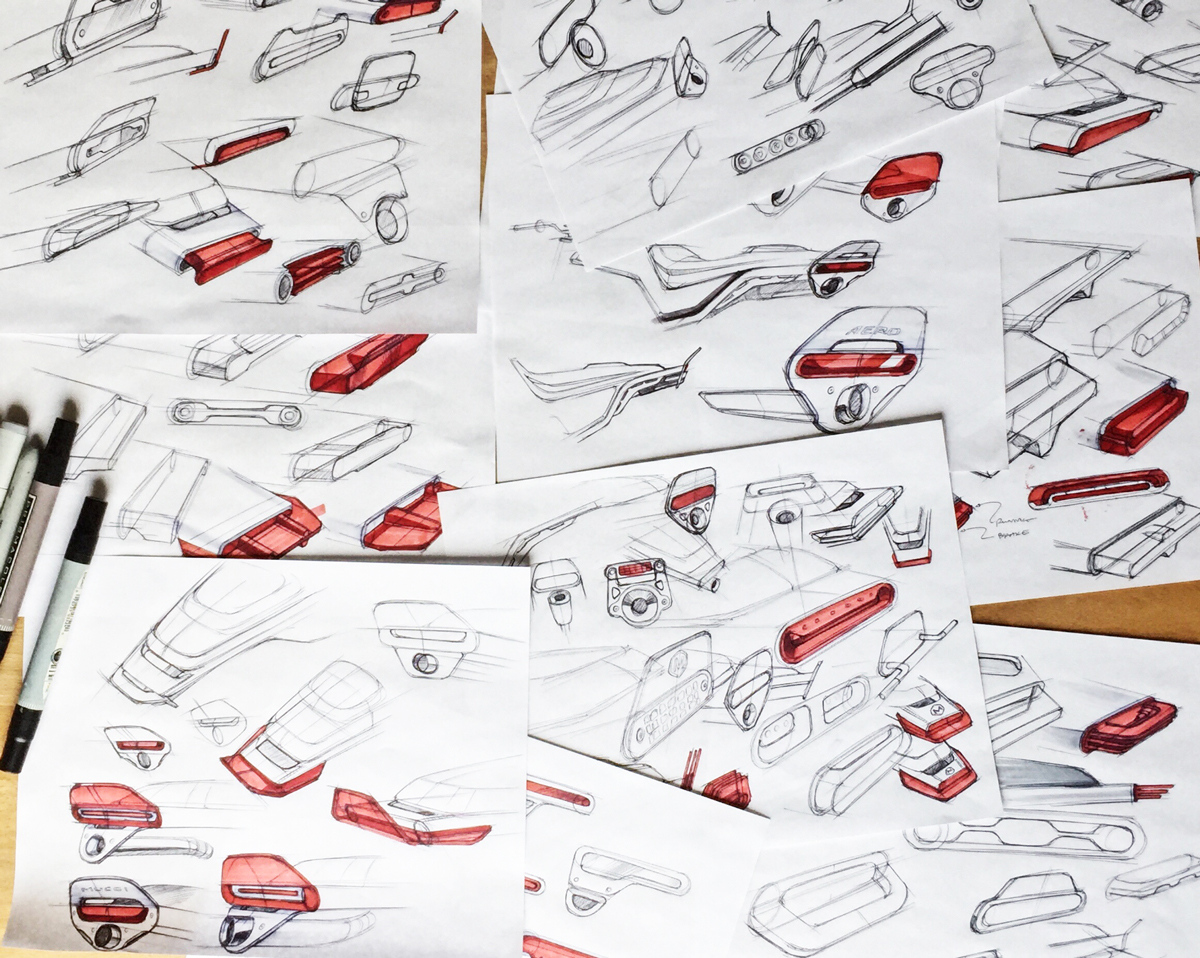
Dave often works out his design in CAD. Here he’s created sketches for a custom subframe on a KTM300 that will hold an integrated lens for the taillight. Photo by Dave Mucci
How did you end up starting your own shop?
After school I worked at a design consultancy in Chicago and quickly realized the standard design profession was much less hands-on than I had hoped. I began conducting my own “design projects” outside office hours in the form of transforming motorcycles. I used a blog to chronicle each step of the process, from concept sketching to final paint and assembly. At the time most custom motorcycle builders were from a mechanical background and decisions were made on the lift table. I think part of the reason the site had so much traffic was people enjoyed seeing the buildup, design, and decision-making process. The community appreciated what I was doing and I soon had enough moto-related work coming in that I was able to leave the office job behind. Currently I try to split my time between building bikes and doing aftermarket design consulting for the motorcycle industry.
Related | Making Harley-Davidson’s LiveWire
How much of being mechanically gifted is interest versus talent? Some of the craftspeople working in metal and fabrication have an artistry that seems impossible to replicate or teach.
I like how Francis of Assisi broke it down into stages: the laborer, the craftsman, and the artist. I would say mechanical ability can be learned. Through interest, ability can be refined into craftsmanship, but you need creativity to turn craftsmanship into artistry. The first two can be taught, but the latter comes down to how you’re wired. A craftsman can replicate artistry, but it takes an artist to create it.
What’s it like when you see the work of an amazing craftsperson? How does that feeling influence your work?
I’d love to say it fills me with ambition and inspiration, but it’s usually anger, self-loathing, and disinterest in whatever I’m working on. I’m competitive and have a short attention span. It’s a bad combination for productivity. It usually takes me a day or so to process how much better someone is than me upon seeing their amazing work. The wave of ambition and inspiration is on its way, it’s just a day late. …I’m working on it.
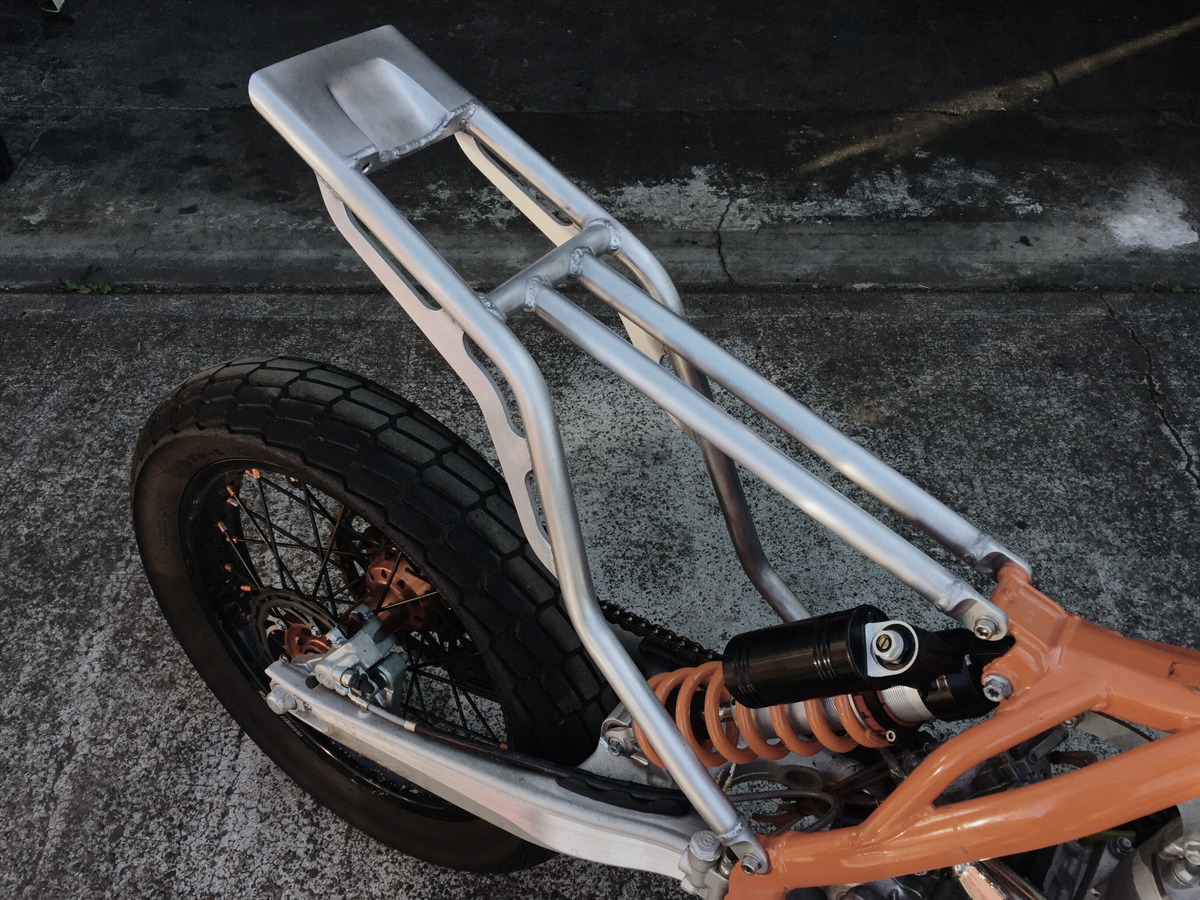
Photo by Dave Mucci
My experience with going to art school was, I went in with an inclination, some raw interests, a bit of passion, and then an enormous system and institution heightened those feelings to a terrifying, near crippling degree. How did art school impact your work?
Crippling is a perfect way to describe art school. I still don’t understand how there’s a degree associated with a curriculum where you define your own workload, its completion is indistinguishable, and your grade is based on opinion. That place was a trip. The most valuable tool I took away from those four years was the ability to reverse engineer objects and define why some appealed to me and others didn’t. After figuring that out I could paint with just the good colors. Just kidding, there are no “good” colors, everything is up for interpretation, “good” is a social construct, gender is fluid, art school is eternal! (laughs)
“I’m often trying something for the first time, whether it’s a new process I’m learning or an unconventional way of building a piece.”
How does that heightened eye for design influence both the quality and vision of your work but also the practical and economical aspects of running a shop?
Oh, it’s terrible. Selling a high-end product in single unit volume is a backwards model and I’m a terrible businessman. As far as my desire for perfection is concerned all things are sacrificial in the name of getting it right. I can effortlessly rationalize spending double the amount of allotted hours on a project. If I send work out into the world I’m not satisfied with it haunts me. The thought of someone having a negative experience with something I made gives me crazy anxiety. I’m often trying something for the first time, whether it’s a new process I’m learning or an unconventional way of building a piece. One-off parts are the nemesis of financial well-being and my desire to always be trying something new isn’t on board with building bikes in assembly line fashion. I’ll often make a part three or four times before I’m satisfied with it. A friend once planted in me the rationalization, “a year from now you won’t remember the money lost, but you’ll remember the work created.” I still haven’t found a counter argument to that—or at least haven’t hit the level of financial ruin necessary to counter it.
Do you ever feel like non-designer custom builders are better off? Like they can just crank out bikes that look neat and flip them? I ask because sometimes I feel like my own training and pickiness in things have almost hindered my ability to get things done. Or, I guess another way of asking it is, are you a perfectionist?
Ooof, really cutting to the core with this one. I’ll say this: There are some people who look at custom bike building as a business and some who look at it as an artistic medium. There are very few people who have been able to master both, and those are my Picassos and Pollocks. To me high volume custom shops are about as satisfying as IKEA art prints.
Related | 40 Years of the BMW GS Motorcycle in Photos
What do you think of the “rolling art” concept? The idea that custom bikes are pieces of one-off art, like a painting or sculpture, and their “motorcycle-ness” is secondary? I see a lot of bikes at shows that absolutely don’t / won’t ever run. From a sculpture perspective I see that as fine I guess, but from a design perspective, isn’t that kind of blasphemy? Doesn’t form always have to follow function?
I’m OK with the rolling art concept to a degree. I can appreciate people who see the motorcycle as a canvas for experimentation. If you go to a major auto show and take a good look at the concept cars, most of them have terrible blind spots, zero ground clearance, pieces that are impossible to manufacture… but they’re still intriguing to look at. They’re a styling exercise; an experiment in pushing the boundaries of our perception of what a car should look like. I appreciate the rolling art bikes for the same reason. They’re someone trying to challenge themselves or challenge your perception. My only caveat is that all the systems still function at least on a low-use level. Sure a lot of them are destined for museums or private collections, but they should still be rideable, even if it’s just down the block. Otherwise why choose a motorcycle to work with?
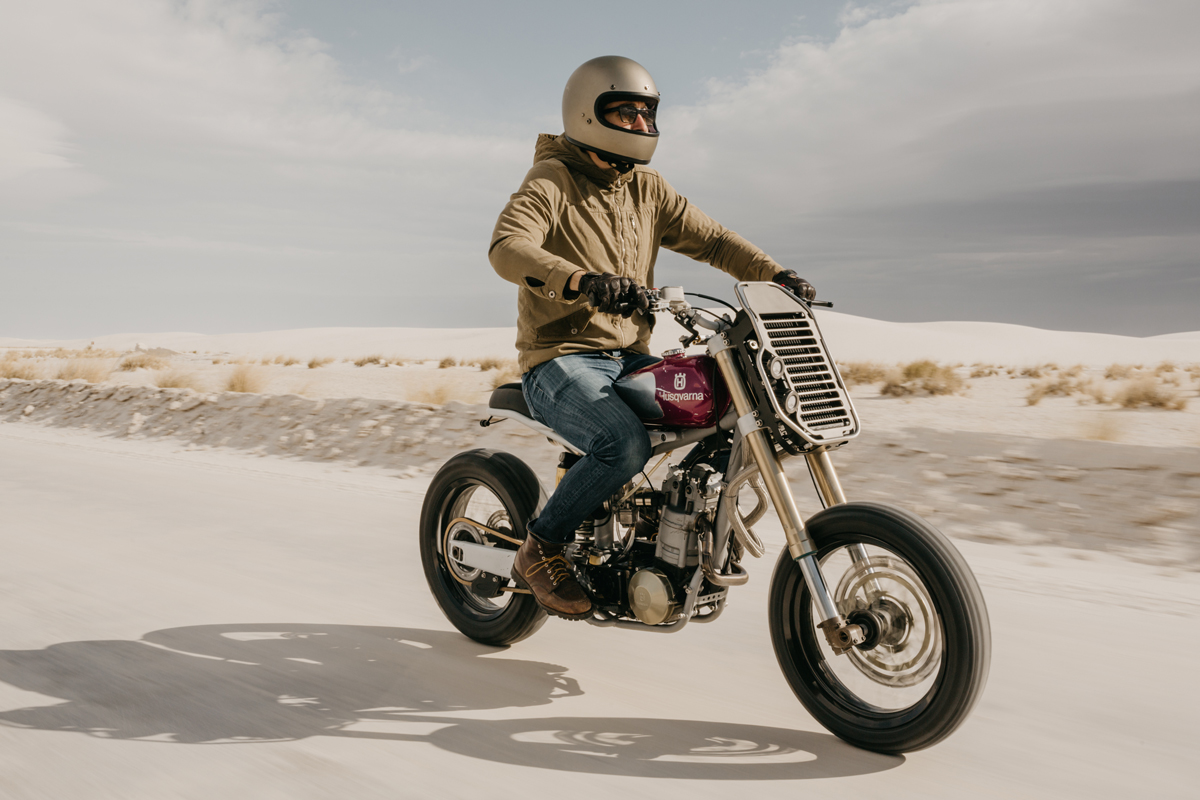
Dave Mucci brings out the Husky in White Sands, New Mexico. “I gravitate toward minimalism in my design work, so Husqvarna TE 570 made sense. It’s a no-frills platform,” he says. Photo by Jenny Linquist
Part of why design interests me is that, at the end of the day, it has to be “finished.” It has to work. Unlike a painting that can be endlessly reworked, design eventually has to be produced. How do you decide when a bike is done?
I treat my custom motorcycle builds like design projects. The client and I go through multiple rounds of sketching and rendering starting at basic silhouettes and ending at a range of CMF options to choose from. I know what the finished bike looks like before picking up a wrench. What isn’t in the renderings are all the little details I’ve yet to work out. I like treating those as their own mini design projects throughout the build. They give me the chance to jump back and forth between designer and builder, exercising different parts of my brain. Designer Dave likes pushing the boundaries of Builder Dave’s skill level.
Who is making awesome bikes these days?
Max Hazan. His bikes are 95% hand-built from raw materials and he comes up with some of the most interesting and beautiful mechanisms I’ve ever seen.
Auto Fabrica. They come at it from a designer’s perspective that I really appreciate. You can just picture the “hot sketch” that led to their bikes. Their experimentations with lighting are also really inspiring.
Thrive MC. A group of young dudes out of Jakarta who are absolutely killing it. They both have a style and don’t. They’ll roll out a raked XL1200 chopper followed by a track inspired CB250. It’s a great shop to follow because they don’t stay within a genre and their take is always original.
Related | Daniel Simon is Transforming the Way We Drive
What about non-motorcycle contemporary designers, who do you like?
Honestly I don’t follow many non-transportation based designers. So much of what I do is based on one-off manufacturing methods that I find more enjoyment following artists and craftsmen than people designing for large volume manufacturing. I follow trans-designers because I love seeing new takes on rendering technique and vehicle surfacing but other than that I like looking outside the realm of design for creative inspiration.
What would your dream bike be to own? Dream car?
My dream bike garage would be owning one from each of my favorite builders. A Max Hazan for the living room. A Walt Siegl ADV for cross-country trips. A Shinya Kimura for the salt flats. There isn’t just one.
Dream car would be the supercharged 1975 BMW 2002 I’m currently building at a very slow pace. My goal is to finish the car then take it on a road trip (from Portland) down the Pacific coast to Mexico with the pup and girlfriend.
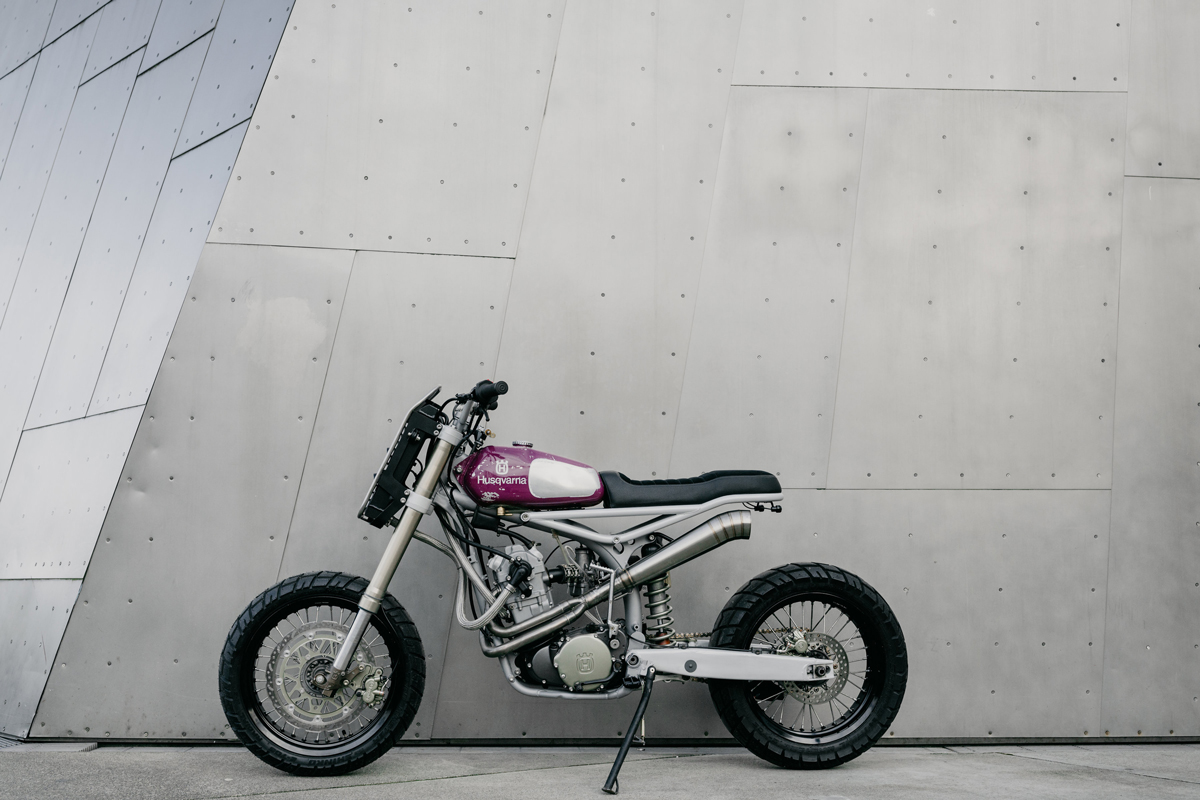
Dave Mucci’s 2001 Husqvarna TE570 was designed to be a light, nimble, wheelie machine perfect for the Pacific Northwest. A highlight of the look is the purple aluminum ’73 CR360 tank. Photo by Jenny Linquist
What non-motorcycle stuff are you working on now?
Just the car really. In addition to the bike builds I’m designing aftermarket part lines for a couple companies. I’m also working on a how-to-draw motorcycles book with a friend who started the iDraw series. It took me awhile to become fully sustained on moto-centric work after quitting consultancy life so I’m cherishing it.
How do you decide to stop working? What keeps you from just living in the shop at all hours?
I like creating mini design projects mid-build to break up the shop time. For instance with the KTM I’m working on I built the subframe per my original design rendering. When I got to how the taillight integrated into the rear of the subframe it wasn’t something I detailed in the rendering. I took a week to step back and iterate on what that area could look like. I started out sketching and eventually built it all in CAD. I ended up having a custom taillight lens machined from polycarbonate and a few other pieces waterjet from aluminum. Then it was back into the shop to weld it all up. I’ll probably do the same for two or three other areas of the bike before I’m finished.
Related | Traveling Southern California with Kawasaki
How do you define success for your shop?
Having a stream of supportive clients that come to me for my vision is a success. As long as I can financially support a lifestyle where I get to push my skills every day and get my work out into the world that’s a win. In the future I’d like for the business to employ a few more hands-on creatives. I need to get some more opinions in here before I drive myself crazy with self-doubt and overanalyzed decisions.
If money and commitments were no issue, is there a project you would love to dive into full-time?
I’d love to design and build a motorcycle for a super-future movie. I think that’d be the pinnacle passion project. That isn’t really what you asked though, is it? There’s definitely money and commitment involved in that. I’m just spewing out the answers I want to give regardless of how relative they are. But for real, movie producers get at me!
If money and commitments were no issue I’d want to build a fleet of ultimate adventure bikes and spend a year touring the world on them with some good friends, McGregor and Boorman style.
What’s a favorite piece of design in your own home? Where did you get it, and why do you love it?
I don’t really collect design pieces. It’s all motorcycles man. I’m pretty 1-dimensional. I currently have six personal project vehicles. There’s also a bunch of MCM furniture that I’ve been meaning to refinish. The non-moto pieces that mean the most to me are the ones from my friends. I made so many connections at school with creatives from other disciplines that are just killing it right now. Photographers, sign painters, metalsmiths… Owning that stuff means more to me than anything from Dieter or Eames.
